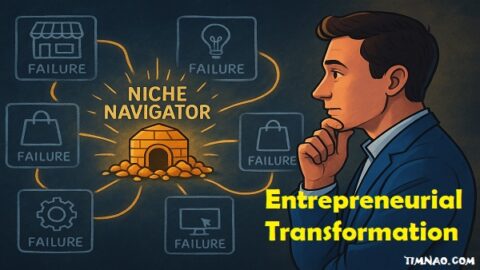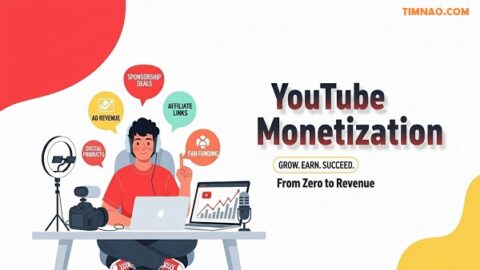Unlock Life-Changing Profitable Side Hustle Ideas 🚀 Start Earning Big Today!
Profitable side hustle ideas aren’t just about making extra money—they’re about creating freedom, flexibility, and new opportunities in your life. Whether you want to pay off debt, save for something big, or eventually quit your 9-to-5, starting a side hustle can be your first step toward financial independence.
The best part? You don’t need a lot of money, experience, or fancy tools to get started. With the right strategy, anyone—from students to full-time professionals—can turn their skills or passions into a sustainable income stream.
In this guide, you’ll learn how to choose the right hustle, explore 10 beginner-friendly ways to start earning, and discover time-tested strategies to grow without burning out. Ready to launch something that could change your life? Let’s dive in.
Table of Contents
- 🚀 Why Start a Side Hustle Today?
- 🎯 How to Choose the Perfect Side Hustle
- 🛠 10 Profitable Side Hustle Ideas for Beginners
- ⏰ Time Management Tips for Busy Hustlers
- 🌐 Using Online Platforms to Boost Your Income
- 💡 Branding & Marketing: Stand Out from the Crowd
- 💸 Monetization Strategies That Actually Work
- 📈 Scaling Your Side Hustle Without Burning Out
- ⚠ Common Mistakes to Avoid
- ✅ Action Plan: How to Launch in 30 Days
- 🙋 FAQs: Beginner Questions About Profitable Side Hustle Ideas Answered
🚀 Why Start a Side Hustle Today?
A side hustle is no longer just “extra cash on the side”—it’s a safety net, a growth engine, and often the first step toward financial independence. The modern economy rewards adaptability, and relying on a single paycheck is riskier than ever. With the right approach, starting a side hustle today can put you ahead of the curve.
1. Financial Freedom and Security
Inflation, layoffs, and rising living costs have pushed many people to seek additional income streams. A side hustle cushions you against these uncertainties. Imagine covering your rent with your 9-to-5 salary while your side hustle pays for vacations, investments, or debt repayment. Over time, that “extra” income can grow into a main source of financial freedom.
2. Turn Passions into Profit
Do you love baking, photography, or social media? A side hustle allows you to monetize what you already enjoy. Many successful entrepreneurs began with hobbies they pursued after work—think YouTubers who turned daily vlogs into full-fledged brands or freelancers who started by offering simple design services on platforms like Fiverr.
3. Build Skills for the Future
Launching a small venture teaches you more than how to make money. You’ll develop valuable skills like digital marketing, project management, and financial planning—skills that boost your resume and prepare you for bigger opportunities, whether in business or employment.
4. Create Multiple Income Streams
Having more than one source of income reduces your dependence on a single employer or industry. This flexibility gives you the power to pivot when life changes, whether you’re planning a career shift or preparing for unexpected challenges.
5. Opportunity Has Never Been Greater
Thanks to digital platforms, anyone can launch a side hustle with minimal investment. From selling digital products on Etsy to building a YouTube channel, barriers to entry have never been lower. The best time to start? Yesterday. The second-best time? Today.
🎯 How to Choose the Perfect Side Hustle
Choosing the wrong side hustle can lead to frustration, burnout, and wasted effort. The right one, however, aligns with your skills, lifestyle, and financial goals—making it sustainable and rewarding. Here’s how to find your ideal fit:
1. Start with Your “Why”
Ask yourself:
- What’s my primary goal? Extra income, passion project, or eventual business?
- What problems do I want to solve?
- What lifestyle do I envision?
Your “why” will guide every decision, from which hustle you pick to how much time you dedicate.
2. Match Skills to Market Demand
List your strengths—both hard and soft skills. Then research how they fit current trends:
- Good at writing? Offer blog posts or copywriting services.
- Love fitness? Start an online coaching program.
- Creative with crafts? Launch a product line on Shopify.
Use tools like Google Trends to check interest levels in your ideas.
3. Validate Before You Commit
Don’t assume your idea will work—test it. Run a quick survey, ask potential customers what they’d pay for, or post sample products/services on social media. Platforms like Reddit and niche Facebook groups are great for gathering feedback before you invest significant time or money.
4. Align with Your Time and Budget
Be realistic about your resources:
- Have 5 hours a week? Focus on gigs with low setup time (e.g., virtual assistant work).
- Willing to invest upfront? E-commerce or digital products may be better options.
- Prefer flexibility? Consider services that allow you to control your schedule, like freelancing or consulting.
5. Think Long-Term Scalability
The best side hustles can grow into something bigger:
- Can you automate tasks?
- Can you create digital products for passive income?
- Can you eventually outsource or hire help?
If your hustle has the potential to scale, you’ll avoid getting stuck trading time for money forever.
🛠 10 Profitable Side Hustle Ideas for Beginners
Not all side hustles are created equal. Some require significant upfront investment, while others can be launched today with nothing but your laptop and determination. Below are 10 realistic, beginner-friendly side hustles you can start right now, complete with examples and practical tips to help you take action.
1. Freelance Services — Sell Your Skills Online
If you have a skill—writing, graphic design, video editing, or social media management—there’s a market for it. Platforms like Fiverr and Upwork connect you with global clients looking for affordable expertise.
How to Start:
- Create a simple portfolio showcasing your best work.
- Start with small gigs to build reviews, then raise your rates.
- Use tools like Canva for design or Grammarly for writing to speed up delivery.
Pro Tip: Niche down. A “TikTok content strategist” often earns more than a generic “social media manager.”
2. Print-on-Demand Products — Create Without Inventory
With print-on-demand (POD), you design products—T-shirts, mugs, phone cases—and companies like Printful or Teespring handle production and shipping.
Why It Works: You never hold stock, and you only pay for products after they’re sold.
How to Start:
- Use Canva or Adobe Express to create simple designs.
- Target a niche audience (e.g., cat lovers, gamers, fitness enthusiasts).
- Promote through Instagram or TikTok to reach your ideal buyers.
3. Blogging with Affiliate Marketing — Write Once, Earn Forever
Blogging can turn your expertise or passion into long-term passive income. Monetize through ads, sponsored posts, and affiliate links—commissions you earn for recommending products.
How to Start:
- Pick a profitable niche (finance, fitness, travel, or tech).
- Set up a website using WordPress.
- Join affiliate programs like Amazon Associates or ShareASale.
Example: A beginner-friendly finance blog reviewing budgeting apps can earn from affiliate partnerships while helping readers save money.
4. Online Courses & Coaching — Teach What You Know
People pay to learn skills they want to master. Whether it’s cooking, coding, or career advice, your knowledge has value.
How to Start:
- Host courses on Teachable or Udemy.
- Offer 1-on-1 coaching via Zoom.
- Start with free content (YouTube, Instagram) to build trust, then upsell premium services.
Pro Tip: Record once, sell forever. Online courses can become a powerful passive income stream.
5. YouTube Channel — Turn Views into Revenue
Video content is booming. Start a channel sharing tutorials, reviews, or vlogs, then monetize through ads, brand deals, and merchandise.
How to Start:
- Use your phone and free editing tools like CapCut or DaVinci Resolve.
- Focus on searchable topics (“How to…” or “Best tools for…”) to attract organic traffic.
- Join the YouTube Partner Program once you hit 1,000 subscribers and 4,000 watch hours.
Example: A channel reviewing affordable gadgets can earn through ad revenue and affiliate links to Amazon.
6. Dropshipping — Sell Products Without Handling Stock
Dropshipping lets you sell products online while suppliers handle storage and shipping.
How to Start:
- Build a store on Shopify.
- Find trending products on AliExpress.
- Use paid ads (Facebook, TikTok) to drive traffic.
Pro Tip: Focus on unique products that solve a problem (e.g., ergonomic gadgets, pet accessories).
7. Virtual Assistant (VA) — Help Businesses Run Smoothly
Entrepreneurs and small businesses need help with tasks like email management, scheduling, and research.
How to Start:
- Create a service list (administration, social media, customer support).
- Offer services on Belay, Time Etc, or LinkedIn.
- Use Trello or Asana to stay organized.
Why It’s Great: You can start with no upfront investment and work entirely from home.
8. Social Media Content Creation — Get Paid to Post
Brands need fresh, engaging content, and they’re willing to pay creators to produce it. Known as UGC (User-Generated Content), this is one of 2025’s hottest trends.
How to Start:
- Create a TikTok or Instagram portfolio showing examples of product videos.
- Pitch to small brands first, then scale to bigger companies.
- Use platforms like Billo or #Paid to find UGC opportunities.
9. Stock Photography — Sell Your Photos Online
If you have a camera or even a good smartphone, you can earn by selling photos on stock sites.
How to Start:
- Upload your work to Shutterstock, Adobe Stock, or Getty Images.
- Focus on high-demand themes like diversity, remote work, and wellness.
- Use editing apps like Lightroom to enhance image quality.
10. Handmade Crafts — Build a Brand Around Creativity
From jewelry to candles to home décor, handmade goods are thriving thanks to platforms like Etsy.
How to Start:
- Create unique, story-driven products (e.g., eco-friendly candles with locally sourced ingredients).
- Market on Pinterest and Instagram for visual impact.
- Attend local markets to build word-of-mouth and gather feedback.
Pro Tip: Combine offline and online strategies. Sell at fairs, then drive traffic to your Etsy shop for repeat orders.
⏰ Time Management Tips for Busy Hustlers
One of the biggest challenges for side hustlers is finding enough time. Between work, family, and personal commitments, your schedule can feel packed. But successful entrepreneurs don’t necessarily work more hours—they work smarter. Here’s how you can maximize productivity and make real progress, even with limited time.
1. Audit Your Current Schedule
Before you add a side hustle to your life, figure out where your time is really going.
- Track your day for a week using apps like Toggl or a simple spreadsheet.
- Identify “time leaks” (e.g., excessive scrolling, binge-watching TV).
- Reclaim just 1–2 hours a day, and you’ll have 7–14 extra hours each week to build your hustle.
Example: Many side hustlers replace 30 minutes of Netflix each evening with focused business tasks—and see results within weeks.
2. Use Time Blocking for Laser Focus
Time blocking means dedicating specific chunks of your day to specific tasks.
- Reserve deep work sessions (e.g., creating content, designing products).
- Assign “light tasks” (e.g., checking emails, posting on social media) to less productive times.
- Tools like Google Calendar or Notion help visually organize your schedule.
Pro Tip: Treat these blocks like non-negotiable meetings. If it’s on the calendar, it happens.
3. Apply the 80/20 Rule (Pareto Principle)
Focus on the 20% of activities that produce 80% of results.
- For bloggers, writing high-quality articles drives more growth than tweaking website colors.
- For freelancers, pitching premium clients often pays more than chasing small gigs.
Ask yourself daily: “Is this task moving me closer to my goals?”
4. Automate and Delegate Early
Your time is your most valuable resource. Use technology and outsourcing to free it up:
- Automate social media posts with Buffer or Hootsuite.
- Use Zapier to connect apps and reduce repetitive tasks.
- Delegate admin work to a virtual assistant via Fiverr or Upwork once you start earning.
Even small automations—like scheduling invoices through QuickBooks—can save hours each month.
5. Batch Similar Tasks
Switching between tasks kills productivity. Instead, batch work:
- Record all videos for the week in one sitting.
- Write multiple blog drafts in a single focused session.
- Respond to emails only twice a day, not constantly throughout the day.
This keeps you in a flow state, allowing higher quality output in less time.
6. Protect Your Energy
Time management isn’t just about minutes—it’s about energy.
- Identify your peak performance hours (morning, afternoon, or night).
- Do your most important tasks when you’re sharpest.
- Take micro-breaks every 60–90 minutes to avoid burnout.
Example: A side hustler who works best in the morning might wake up an hour earlier to focus on their business before heading to their 9-to-5.
7. Set SMART Goals and Micro-Milestones
Big goals can feel overwhelming, leading to procrastination. Break them into smaller wins:
- Instead of “Launch my online store,” try:
- Choose niche (Day 1)
- Register domain (Day 2)
- Upload first product (Day 3)
Pro Tip: Celebrate these micro-wins. They build momentum and keep motivation high.
8. Learn to Say No
Every “yes” to distractions is a “no” to your future.
- Politely decline activities that don’t align with your goals.
- Limit mindless browsing by setting app timers (iOS Screen Time or Android Digital Wellbeing).
- Remember: a side hustle is temporary sacrifice for long-term freedom.
9. Review and Adjust Weekly
End each week with a 15-minute review:
- What worked well?
- What drained time with little payoff?
- How can you adjust for next week?
This reflective practice keeps you adaptive and efficient.
10. Embrace Imperfect Action
The perfect schedule doesn’t exist. Life happens—work emergencies, family events, mental fatigue. What matters is consistency, not perfection.
Even 15 minutes a day compounds into massive progress over months. Done is better than perfect.
🌐 Using Online Platforms to Boost Your Income
Online platforms are the backbone of modern side hustles. They give you access to a global audience, tools to automate your business, and opportunities to scale faster than ever before. Whether you’re selling products, offering services, or building a personal brand, the right platforms can make or break your success.
1. E-Commerce Platforms — Sell Products Without Limits
You don’t need a physical store to launch a product-based business. E-commerce platforms make it easy to start selling within hours:
- Shopify: Ideal for dropshipping, print-on-demand, and branded online stores.
- WooCommerce: Perfect for WordPress users who want more customization.
- Etsy: Best for handmade crafts, digital downloads, and creative products.
Pro Tip: Use product research tools like EcomHunt or Google Trends to identify what’s in demand before launching.
2. Freelance Marketplaces — Turn Skills into Cash
If you’re offering services, freelance marketplaces provide instant access to paying clients:
- Fiverr: Great for beginners offering quick, affordable services.
- Upwork: Ideal for professionals seeking long-term contracts and higher rates.
- Toptal: For advanced freelancers aiming to work with premium clients.
How to Stand Out: Create a professional profile, add a portfolio, and ask early clients for reviews to build credibility quickly.
3. Social Media Platforms — Build Influence and Trust
Social media isn’t just for posting memes—it’s a sales engine if used strategically:
- Instagram & TikTok: Showcase products and share short, engaging videos to drive traffic.
- Pinterest: Perfect for visual niches like food, travel, and home décor.
- LinkedIn: Ideal for freelancers, consultants, and B2B service providers.
Pro Tip: Use free tools like Buffer or Hootsuite to schedule posts and maintain consistency without spending all day online.
4. Online Learning Platforms — Teach What You Know
If you’re an expert in something, platforms exist to help you package that knowledge:
- Teachable: Build and sell your own courses.
- Udemy: Tap into an existing audience searching for affordable courses.
- Skillshare: Earn royalties as students watch your classes.
Why It Works: Digital products can be sold an unlimited number of times, making this a scalable income source.
5. Content Monetization Platforms — Get Paid for Creativity
Turn your ideas into income with platforms that reward creators:
- YouTube: Monetize through ads, sponsorships, and memberships.
- Patreon: Offer exclusive content to monthly subscribers.
- Substack: Build a paid newsletter around your expertise.
Example: A photographer could share tutorials on YouTube, offer exclusive presets on Patreon, and sell digital prints through Etsy.
6. Marketplaces for Digital Assets — Sell Once, Earn Repeatedly
Digital assets like templates, stock photos, or music tracks can generate ongoing income:
- Envato Elements: Sell design templates, graphics, and stock footage.
- Shutterstock: Upload photos and videos for recurring royalties.
- AudioJungle: Perfect for musicians creating soundtracks or jingles.
Pro Tip: Focus on evergreen content (e.g., productivity templates, business stock images) that stays relevant over time.
7. Automation Tools to Scale Faster
Once you start gaining traction, automation helps you save time and grow efficiently:
- Zapier: Connect apps to automate tasks (e.g., send invoices after each sale).
- ConvertKit: Build email lists and nurture leads automatically.
- RankMath: Optimize your website for SEO to attract organic traffic.
8. Choosing the Right Platform Mix
Not every platform fits every hustle. Consider:
- Where is your audience? (Visual? Text-based? Business-focused?)
- How do you want to monetize? (Products, services, digital assets, or ads?)
- How much control do you need? (Own website vs. third-party platform.)
Example Mix for a Handmade Business: Sell physical products on Etsy, share tutorials on YouTube, and grow an email list with ConvertKit to launch new products.
💡 Branding & Marketing: Stand Out from the Crowd
Launching a side hustle is one thing—getting noticed is another. With so many people starting online businesses, branding and marketing are your secret weapons. Strong branding helps you connect emotionally with your audience, while smart marketing ensures your products or services reach the right people at the right time.
1. Build a Brand That Resonates
Your brand is more than just a logo—it’s the story and personality behind your hustle.
- Define Your Why: Why did you start? What problem are you solving?
- Create a Brand Identity: Choose colors, fonts, and visuals that reflect your style. Tools like Canva make this beginner-friendly.
- Craft a Brand Voice: Are you professional and authoritative? Fun and quirky? Authentic messaging creates trust.
Example: A handmade candle business might position itself as eco-conscious, using earthy colors and storytelling around sustainable living.
2. Develop a Unique Selling Proposition (USP)
A USP answers: “Why should people choose you over competitors?”
- Offer something distinct: better quality, faster service, unique designs, or personalized experiences.
- Research competitors to identify gaps you can fill.
- Keep it simple and memorable.
Pro Tip: Put your USP everywhere—your website, social media bios, and product descriptions.
3. Leverage the Power of Content Marketing
Content builds trust and attracts organic traffic without heavy ad spending.
- Start a blog on WordPress to share valuable tips in your niche.
- Create short-form videos for TikTok and Instagram Reels.
- Use Pinterest for visual storytelling if you sell crafts, design services, or lifestyle products.
Example: A fitness coach might share free workout tips on YouTube, then funnel viewers to paid coaching programs.
4. Master Social Proof to Build Trust
People trust businesses that others recommend. Use:
- Testimonials and Reviews: Ask early customers for feedback and display it prominently.
- Case Studies: Show real results from your product or service.
- User-Generated Content (UGC): Repost customer photos to create a sense of community.
Platforms like Trustpilot and Loox can help automate review collection.
5. Use SEO to Get Discovered Organically
Search Engine Optimization (SEO) makes your hustle visible to people actively searching for what you offer.
- Use RankMath or Yoast SEO to optimize your website.
- Research keywords using Ubersuggest or Ahrefs.
- Focus on creating helpful content that answers your audience’s questions.
Pro Tip: Include your main keyword in your titles, meta descriptions, and throughout your content—but keep it natural.
6. Experiment with Paid Advertising
If you have a small budget, ads can speed up your growth:
- Facebook & Instagram Ads: Great for targeting specific interests.
- TikTok Ads: Affordable and highly effective for viral products.
- Google Ads: Perfect for services or products people actively search for.
Start small, test different creatives, and double down on what converts.
7. Build an Email List from Day One
Social media algorithms change, but an email list is yours forever.
- Offer a freebie (e.g., checklist, discount code, or mini-course) to encourage sign-ups.
- Use tools like ConvertKit or Mailchimp.
- Send weekly updates with valuable tips and occasional offers to nurture relationships.
8. Collaborate to Expand Your Reach
Partnerships help you grow faster by tapping into someone else’s audience:
- Partner with complementary businesses for joint giveaways.
- Guest post on blogs or appear on podcasts in your niche.
- Use influencer marketing—start with micro-influencers who genuinely connect with your target market.
9. Track What’s Working (and Drop What’s Not)
Marketing without data is guesswork.
- Use Google Analytics to track website traffic.
- Check social media insights to see which posts get the most engagement.
- Test one marketing channel at a time to avoid spreading yourself too thin.
10. Stay Consistent and Human
People buy from brands they know, like, and trust.
- Show up regularly on your chosen platforms.
- Share your story and behind-the-scenes moments to create authenticity.
- Focus on building relationships, not just making sales.
💸 Monetization Strategies That Actually Work
A side hustle isn’t just about working hard—it’s about making your effort pay off. Many beginners focus on creating products or services but overlook how to monetize effectively. The right strategy can turn a small hustle into a steady income stream, and eventually, a thriving business. Here’s how to do it step by step.
1. Start with a Clear Revenue Model
Before you launch, decide how you’ll get paid:
- Direct Sales: Sell products or services directly to customers.
- Subscriptions: Charge recurring fees for ongoing access (great for digital products or memberships).
- Affiliate Marketing: Earn commissions by promoting other companies’ products.
- Ad Revenue: Monetize through platforms like YouTube or blogging networks.
Pro Tip: Begin with one model, then add others as your hustle grows.
2. Offer Entry-Level Products to Build Trust
Instead of trying to sell expensive packages right away, start with low-cost offers:
- E-books under $20
- Mini-courses under $50
- Affordable “starter” services (e.g., logo design for small businesses)
This builds customer confidence and creates a pathway to higher-value offers later.
3. Upsell and Cross-Sell Strategically
Once someone buys from you, they’re more likely to purchase again.
- Upsell: Offer a premium version of your product or service.
- Cross-sell: Recommend related products (e.g., a blogger selling templates alongside an e-book).
Example: A freelance writer could sell blog packages, then upsell SEO optimization services.
4. Bundle for Perceived Value
Bundles make customers feel like they’re getting more for less:
- Combine products (e.g., three courses for the price of two).
- Create service packages (e.g., social media management plus content creation).
- Use tiered pricing so buyers can choose what suits them best.
5. Build Recurring Income Streams
Consistency is key to long-term success:
- Create a membership site using platforms like Patreon or Podia.
- Offer retainer services (e.g., monthly consulting or design support).
- Develop digital assets—templates, presets, or guides that can be sold repeatedly.
6. Leverage Affiliate Partnerships
Affiliate marketing is powerful because it requires no product creation.
- Join programs like Amazon Associates, ShareASale, or niche-specific affiliate networks.
- Promote products you genuinely use and believe in.
- Integrate links naturally in blogs, YouTube descriptions, or social media posts.
7. Monetize with Advertising (Once You Have Traffic)
Ads are effective once you’ve built an audience:
- Display Ads: Use networks like Google AdSense on blogs or niche websites.
- Video Ads: Enable monetization on YouTube through the Partner Program.
- Sponsored Content: Partner with brands for posts, videos, or newsletters.
Example: A TikTok creator showcasing cooking tips can earn from ad views and brand sponsorships simultaneously.
8. Create Premium Content for Your Best Fans
People pay for exclusivity and deeper value:
- Offer VIP coaching sessions or mastermind groups.
- Sell exclusive tutorials, behind-the-scenes content, or early product access.
- Use platforms like Gumroad or Ko-fi to sell digital downloads easily.
9. Scale Through Automation
Once you find what works, free yourself from repetitive tasks:
- Set up automated email funnels with ConvertKit.
- Use Zapier to connect sales and delivery (e.g., deliver a digital product instantly after purchase).
- Create evergreen products—like courses or e-books—that sell without constant effort.
10. Reinvest to Grow
Don’t spend all your profits immediately. Smart reinvestment accelerates success:
- Upgrade tools (better website hosting, ad tracking software).
- Outsource tasks (hire a designer, editor, or virtual assistant).
- Test paid ads to reach more people faster.
Pro Tip: Treat your side hustle like a business, not a hobby, and your income potential will multiply.
📈 Scaling Your Side Hustle Without Burning Out
Starting a side hustle is exciting, but scaling it is where the real growth—and real challenges—begin. Many beginners make the mistake of thinking “more hours = more success,” only to burn out and give up. The truth? Scaling effectively means working smarter, building systems, and protecting your energy so your hustle can grow sustainably.
1. Focus on What Works (and Drop What Doesn’t)
As your hustle gains traction, track your results:
- Which products or services bring the most profit?
- Which marketing channels actually convert?
- Which tasks feel like time-wasters?
Use tools like Google Analytics, Trello, or Notion to review performance weekly. Then double down on the strategies that produce results and cut the rest.
2. Streamline Your Workflow with Automation
Automation allows you to grow without adding extra hours:
- Automate social media posts using Buffer or Later.
- Set up email funnels with ConvertKit to nurture leads automatically.
- Use Zapier to connect apps (e.g., automatically send a welcome email after a sale).
Pro Tip: Start small. Automate one task per month, and soon, your business will run like clockwork.
3. Outsource to Free Up Your Time
You don’t need to do everything yourself.
- Hire freelancers on Fiverr or Upwork for design, video editing, or customer support.
- Delegate repetitive tasks like data entry or scheduling to virtual assistants.
- Invest in professionals (accountants, ad managers) as your income grows.
Think of outsourcing as buying back your time to focus on high-value activities.
4. Standardize Your Processes
Create systems so your hustle doesn’t depend on constant improvisation:
- Write step-by-step SOPs (Standard Operating Procedures) for recurring tasks.
- Use project management tools like Asana or ClickUp to keep everything organized.
- Store templates for emails, proposals, and invoices to speed up operations.
This not only saves time but also makes it easier to train others when you expand.
5. Diversify Your Income Streams
Once you’ve established a solid foundation, add complementary revenue streams:
- A freelancer can sell templates or courses.
- An e-commerce store can launch digital downloads or subscription boxes.
- A content creator can add affiliate marketing or paid memberships.
Diversification makes your hustle antifragile—resilient even if one stream slows down.
6. Raise Your Prices with Confidence
As demand grows, don’t be afraid to charge more:
- Highlight your results through testimonials and case studies.
- Offer premium packages for customers who want extra value.
- Gradually increase rates to reflect your improved skills and brand credibility.
Example: A designer who started at $50 per logo could scale to $500+ by building a portfolio and reputation.
7. Protect Your Energy with Boundaries
Scaling isn’t worth it if it costs your health:
- Set clear work hours and stick to them.
- Use time blocking to separate hustle tasks from personal life.
- Schedule breaks and days off to recharge—burnout kills momentum faster than slow growth.
8. Measure Success Beyond Money
Scaling isn’t just about earning more—it’s about freedom and impact:
- Are you working fewer hours for the same (or higher) income?
- Are you creating value for your audience or clients?
- Does your hustle align with your long-term vision?
Regular reflection helps you stay motivated and focused on what really matters.
9. Build a Community Around Your Brand
A loyal audience can become your biggest growth engine:
- Create a free Facebook Group or Discord server.
- Host live sessions on Instagram or YouTube to engage directly.
- Encourage user-generated content to boost visibility.
Pro Tip: A strong community reduces marketing costs and increases repeat business.
10. Think Like a CEO, Not Just a Hustler
At some point, your side hustle shifts from “extra income” to “business.”
- Reinvest profits into tools, ads, or education.
- Plan for taxes and legal structures (consult a professional).
- Set quarterly goals, not just weekly tasks, to guide long-term strategy.
⚠ Common Mistakes to Avoid
Starting a side hustle is exciting, but beginners often fall into traps that slow growth, waste money, or cause burnout. Avoiding these mistakes early can save you months of frustration and help you build a sustainable path to success.
1. Jumping in Without a Plan
Many people start hustling without defining clear goals. They pick random ideas, hoping one will work.
How to Avoid:
- Set SMART goals (Specific, Measurable, Achievable, Relevant, Time-bound).
- Decide upfront what success looks like—extra $500/month? Transition to full-time? Passive income?
- Outline your first 30-day action plan to stay focused.
2. Chasing Too Many Ideas at Once
Shiny object syndrome kills momentum. Trying to juggle dropshipping, freelancing, and blogging simultaneously often leads to mediocre results everywhere.
How to Avoid:
- Start with ONE hustle until it’s profitable or systemized.
- Use a “parking lot” list for future ideas to revisit later.
3. Underestimating the Time Commitment
A profitable side hustle rarely happens overnight. Many quit when results don’t appear quickly.
How to Avoid:
- Treat your hustle like a part-time business, not a hobby.
- Commit realistic hours (e.g., 5–10 hours weekly) and stay consistent.
- Track progress monthly rather than obsessing daily.
4. Ignoring Market Research
Building products or services without validating demand is a fast track to disappointment.
How to Avoid:
- Use tools like Google Trends, AnswerThePublic, or niche-specific forums to check demand.
- Test your idea with a small audience before going all-in.
5. Neglecting Branding and Marketing
A great product won’t sell if no one knows it exists.
How to Avoid:
- Build a simple but strong online presence (website + 1–2 social channels).
- Share valuable content to build trust, not just promotions.
- Invest time in learning basic SEO and social media strategies.
6. Pricing Too Low (or Too High Without Proof)
Beginners often underprice out of fear or overprice without building trust. Both can hurt growth.
How to Avoid:
- Research competitor pricing.
- Start competitively, then raise rates as you gain testimonials and experience.
- Emphasize value over price by highlighting benefits and results.
7. Failing to Track Finances
Without financial awareness, it’s easy to overspend or miscalculate profits.
How to Avoid:
- Separate personal and business accounts.
- Use tools like QuickBooks, Wave, or Notion to track income and expenses.
- Set aside a percentage of earnings for taxes.
8. Overcomplicating Too Soon
Many hustlers waste time perfecting logos, websites, and business cards instead of selling.
How to Avoid:
- Start lean. Focus on generating sales or clients first.
- Upgrade branding and tools gradually as revenue grows.
9. Comparing Yourself to Others
Seeing others post six-figure results online can be demotivating.
How to Avoid:
- Focus on your progress, not someone else’s timeline.
- Celebrate small wins—your first sale is a bigger milestone than it seems.
- Follow creators who inspire action, not overwhelm.
10. Forgetting to Protect Your Health
Hustling 24/7 leads to burnout and kills creativity.
How to Avoid:
- Schedule breaks and downtime just like work tasks.
- Get enough sleep, exercise, and mental rest.
- Remember: a sustainable hustle beats an unsustainable grind.
✅ Action Plan: How to Launch in 30 Days
Many aspiring hustlers never start because they think it’s “not the right time” or they “need more preparation.” The truth? You can launch a side hustle in just 30 days if you follow a focused plan. This step-by-step roadmap keeps things simple and actionable so you can move from idea to income—fast.
Week 1: Pick Your Hustle and Validate Your Idea
Goal: Find the right hustle for your skills, lifestyle, and market demand.
- Define Your Why: Is it extra income, passion, or a path to full-time business?
- List Your Skills and Interests: Match what you’re good at with what excites you.
- Research Market Demand: Use Google Trends, Reddit communities, and competitor analysis to confirm people actually want what you’re offering.
- Quick Validation: Share a survey, pre-sell to friends, or post a teaser on social media to gauge interest.
Deliverable by Day 7: One validated hustle idea you’re confident to pursue.
Week 2: Build Your Foundation
Goal: Create a simple setup to start selling without overcomplicating.
- Choose Your Platform:
- Create a Minimum Viable Brand:
- Simple logo using Canva
- Clear tagline describing what you offer
- Basic color scheme for consistency
- Set Up Payment Channels: Link PayPal, Stripe, or your preferred gateway.
- Draft a Launch Offer: Start with one product, service, or piece of content you can deliver quickly.
Deliverable by Day 14: Your hustle is set up online and ready to showcase.
Week 3: Launch and Get Your First Sale
Goal: Put your hustle in front of real people and generate income.
- Announce Publicly: Share your launch on social media, LinkedIn, or relevant communities.
- Use Outreach Strategies:
- Services: Send pitches to 10–20 potential clients.
- Products: Offer a limited-time discount to early buyers.
- Content: Collaborate with micro-influencers for exposure.
- Collect Social Proof: Ask your first customers for testimonials or reviews.
- Track Results: Monitor traffic, engagement, and responses to see what’s working.
Deliverable by Day 21: Your first sale or meaningful lead secured.
Week 4: Refine and Prepare to Scale
Goal: Turn your launch into a repeatable process.
- Analyze Feedback: What did customers love? What needs improvement?
- Polish Your Offer: Improve product quality, refine services, or optimize your content.
- Automate One Task: Schedule posts with Buffer or create an email sequence with ConvertKit.
- Plan Your Next Step: Decide whether to add a new product, increase prices, or expand marketing efforts.
Deliverable by Day 30: A streamlined hustle ready for consistent growth.
Quick Tips for Success in 30 Days:
- Stay Lean: Focus on income-producing activities, not perfection.
- Document Your Journey: Share behind-the-scenes content to build authenticity.
- Celebrate Small Wins: Every milestone—first follower, first sale, first positive review—keeps you motivated.
🙋 FAQs: Beginner Questions About Profitable Side Hustle Ideas Answered
When starting a side hustle, beginners often face similar doubts and fears. Here are the most common questions—and straightforward answers—to help you move forward with confidence.
1. What’s the easiest side hustle to start with no money?
Some of the best profitable side hustle ideas require little to no upfront investment:
- Freelancing: Offer writing, design, or virtual assistant services on Fiverr.
- Social Media Content Creation: Create user-generated content (UGC) for brands using just your phone.
- Affiliate Marketing: Promote products through blogs or social media and earn commissions without holding inventory.
Pro Tip: Start with skills you already have—this reduces costs and speeds up your launch.
2. How much can I realistically earn from a side hustle?
It depends on the hustle and your effort:
- Freelancers often earn $500–$2,000/month once established.
- E-commerce stores can scale to several thousand dollars monthly, but require more setup.
- Content creators (blogs, YouTube) may take longer to grow but can generate passive income over time.
Mindset Shift: Focus first on your first $100—then scale gradually.
3. How do I know which side hustle is right for me?
Ask yourself:
- Do I enjoy the work enough to stay consistent?
- Does it fit my schedule? (Service-based hustles are flexible; e-commerce needs more setup.)
- Is there proven demand? Use Google Trends or check marketplaces like Etsy to validate.
Tip: Start small and pivot if necessary. Many successful entrepreneurs tested multiple ideas before finding their winner.
4. Do I need to register a business to start?
Not necessarily. In most countries, you can start earning as a sole proprietor. However:
- Check local tax requirements early to avoid surprises.
- Once you start earning consistently, consider registering for legal protection and credibility.
Tools like QuickBooks or Wave can help track finances from day one.
5. How do I find time for a side hustle with a full-time job?
Time management is key:
- Use time blocking to dedicate 1–2 hours daily.
- Automate repetitive tasks with Buffer or Zapier.
- Start with micro-actions (e.g., one client pitch per day) to build momentum.
Even 5 focused hours a week can grow into something meaningful.
6. Do I need a website or social media to succeed?
Not always. Many hustlers start without either:
- Freelancers can land clients directly through platforms like Upwork.
- Product sellers can use marketplaces like Etsy or Shopify templates.
- Content creators can grow entirely on YouTube or TikTok.
A website and social media become more important as you scale and want full control of your brand.
7. How long before I start making money?
- Service-based hustles: Often within 1–4 weeks.
- Product-based hustles: Usually 1–3 months after launching.
- Content-based hustles: Can take 6+ months but create long-term passive income.
Golden Rule: The more value you deliver, the faster you’ll see results.
8. Can I turn my side hustle into a full-time business?
Absolutely. Many thriving businesses started small:
- A freelance designer expands into an agency.
- A blogger grows into an online educator with courses and memberships.
- A dropshipper evolves into a branded e-commerce store.
Key Step: Reinvest profits into tools, marketing, and outsourcing to free up your time.
9. What’s the biggest mistake beginners make?
The top mistakes are:
- Chasing too many ideas at once.
- Ignoring market research.
- Giving up too early when results are slow.
Consistency beats perfection. Small actions, done daily, compound over time.
10. Where should I start today?
- List three skills, interests, or hobbies you could monetize.
- Spend 30 minutes researching demand.
- Take one immediate action—sign up on a platform, draft a social media post, or outline your first offer.
Remember: Action creates clarity. You don’t need the perfect plan to begin.
Disclaimer
This article is for educational and informational purposes only. While the strategies and examples shared are designed to help beginners explore profitable side hustle ideas, results will vary based on individual effort, skills, market conditions, and other factors.
We do not guarantee specific earnings, and this content should not be considered financial, legal, or professional advice. Before starting any business or investment, you are encouraged to conduct your own research and, where necessary, consult with qualified professionals.
Any mentions of third-party platforms or tools are for reference only and do not constitute endorsements. Use them at your discretion and review their terms and policies before engaging.










Very well presented. Every quote was awesome and thanks for sharing the content. Keep sharing and keep motivating others.
Hi there to all, for the reason that I am genuinely keen of reading this website’s post to be updated on a regular basis. It carries pleasant stuff.
Thanks for your interest!!!